
Genesis 6
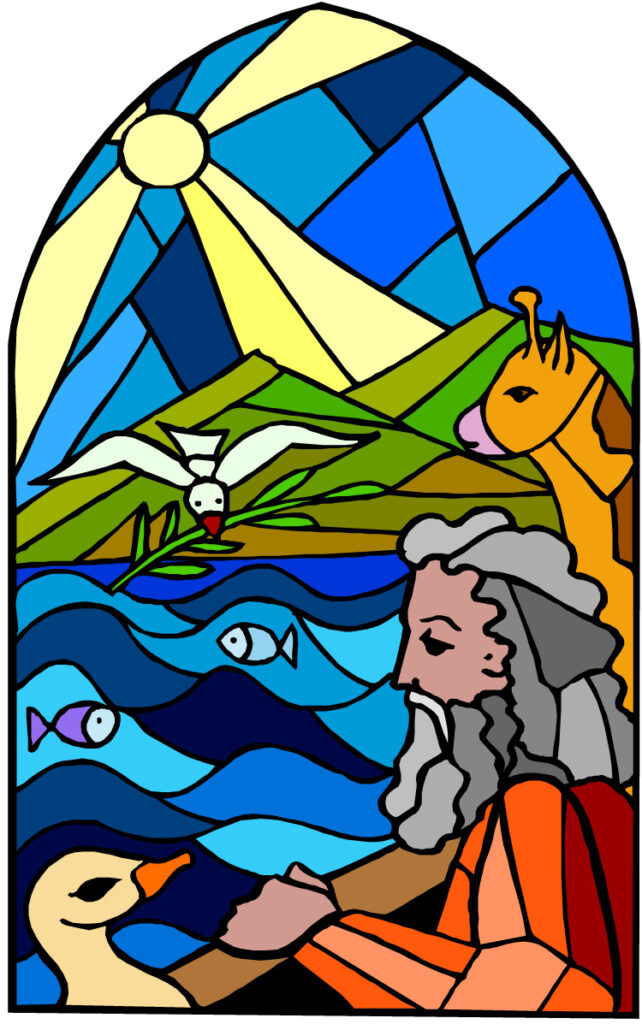
Genesis 6:9, The character of Noah. This passage lists the character attributes of Noah. The character sketch of this man of Elohim who preached righteousness to a generation of unmitigated evil people commences this way: “These are the generations [Heb. toledaw] of Noah: Noah was a just [Heb. tzaddiyq] man and perfect [Heb. tamiym] in his generations [Heb. dowr], and Noah walked with Elohim.”
- Generations is the Hebrew word toledaw meaning “descendants, genealogies, or results.”
- Just is the Hebrew word tzaddiyq meaning “a lawful, righteous man.”
- Perfect is the Hebrew word tamiym meaning “entire, integrity, truth, without blemish, complete, full, undefiled, or upright”.
The word generations at the end of the verse is the Hebrew word dowr meaning “a man’s lifetime beginning with the womb of earth and returning thereto…likewise from conception and birth of a man to the conception and birth of his offspring” (The TWOT).
Is it possible to be just and perfect and have a faith in and a love for YHVH without walking in a Torah-obedient lifestyle? No. After all, it is YHVH’s Torah that defines the biblical standard of righteousness (Ps 119:172). Noah kept himself separate and unspotted spiritually from the world around him; although he was in the world, he was not of the world. He and his family lived set-apart, kadosh lives separate from the evil and the filth of the immorality around them. Some Bible scholars find an additional understanding in this verse, as well, in that Noah and his sons did not intermarry with the fallen ones (or nephilim) who were the offspring of the daughters of men and the sons of Elohim (i.e., the fallen angels; Gen 6:4).
The “sons of Elohim” in Genesis 6:4 are fallen angles who had relations with daughters of men thus producing the giants (Heb. nephilim) on the earth. This unlawful sexual activity corrupted the human gene pool. At the same time, Noah’s ancestors and descendents refused to intermarry with the nephilim and were thus from an undiluted genetic strain going back to Adam. What is the lesson here for us? Are you living a life totally set-apart from the corrupting influences (both physical and spiritual) of the fallen world around you? Are you encouraging your children to marry inside the faith, and not to intermarry with the ungodly heathens, who will likely exercise a negative influence on them, thus dragging your children downward morally and spiritually?
After all, who can deny the fact that the Bible is the tragic story from cover to cover of the ungodly corrupting the godly, for “evil companionship corrupts good morals” (1 Cor 15:33). Seldom does the opposite occur. This is why Scripture admonishes the saints to “‘[c]ome out from among them and be separate,’ says YHVH. ‘Do not touch what is unclean, and I will receive you,’” (2 Cor 6:17).On many occasions, YHVH rebuked and punished the Israelites for falling into the trap of compromise and acquiescence to the wicked influences around them, which inevitably led to spiritual degradation, immorality, idolatry and divine judgement. This is exactly what occurred to Noah’s generation.
Genesis 6:9, Perfect [Heb. tamiym] in his generation [Heb. dor]. The Hebrew word tamiym means “entire, complete, whole (literally, figuratively or morally); also (as a noun) “integrity, truth.” Dor means “a revolution of time, that is, an age or generation; also a dwelling.” Tamiym is translated in the KJV as “without blemish, complete, full, perfect, sincerely (-ity), sound, without spot, undefiled, upright (-ly), whole.” Thus the idea that this verse suggests that Noah’s genome was pure and untainted by nephilim DNA may hold merit, but it is primarily an indication of his moral and spiritual status before YHVH.

Noah walked with Elohim. What does it mean to walk with Elohim? The word walk is the Hebrew word halak/lKV. This word can mean walking physically or figuratively in a spiritual sense. In numerous places in the Scriptures, halak is used in reference to one who lives a Torah-obedient lifestyle; that is, one who walks in the righteous instructions, precepts and teachings of YHVH as outlined in his Word (Ps 119:1, 3). Conversely, there is a walk of darkness for those who walk contrary to the Torah-law of YHVH (Isa 59:9). In Amos 3:3, YHVH asks of his people, “Can two walk together, except they be agreed?” In Hebrew thought, one’s walk in this context is referring to one’s spiritual walk. Numerous times YHVH commands his people to walk in all his ways (i.e., in the instructions and teachings of YHVH’s Torah). Because Noah walked in YHVH’s ways, he found grace (kindness, favor, preciousness) in the eyes of YHVH and was spared from judgment (Gen 6:8).
Genesis 6–7
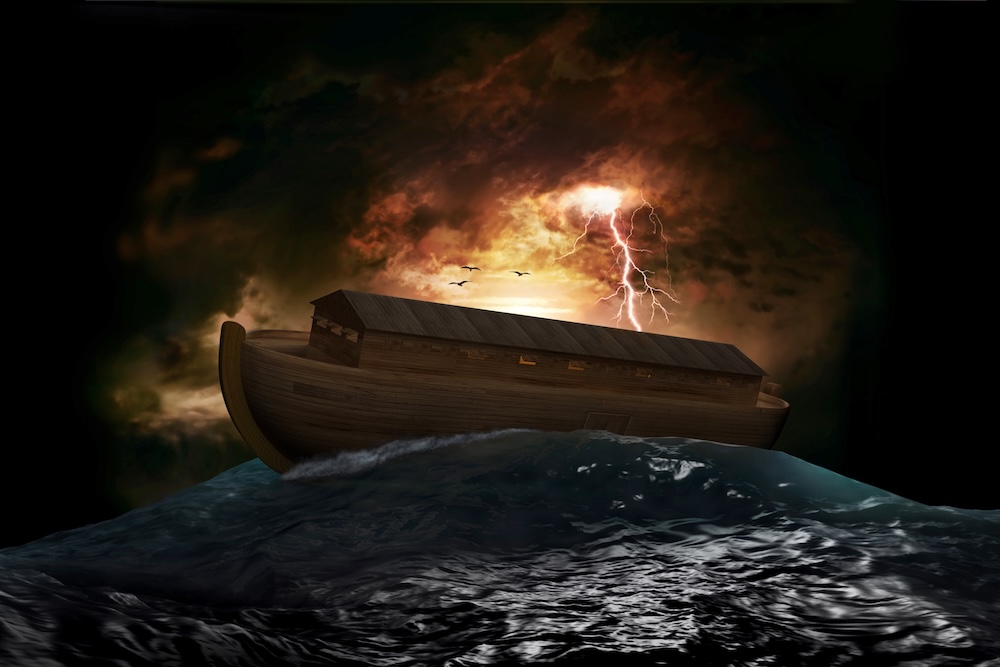
Genesis 6–8, Noah’s flood provides allegorical insights relating to end-times prophecy. In Matthew 24:37, Yeshua compares the end times to the days of Noah. This teaches us that in the eyes of Yeshua, the story of Noah has allegorical implications that give hints about end-times prophecy.
In 1 Peter 3:18–22, we learn that the story of Noah is also a picture of salvation and water baptism. Thus Noah is a prophetic antetype of Yeshua.
To start with, Noah building the ark is a prophetic picture of the redeemed believer working out his own salvation (Phil 2:12), yet while doing so according to YHVH’s exact plans or specifications (e.g., repentance from sin, faith in Yeshua, baptism for the remission of sins, and faithful obedience to YHVH’s commandments).
Noah builds an ark of safety from Elohim’s wrath or judgments against sinful man. The ark is a metaphorical picture of the believer’s salvation, and Noah is a spiritual picture of Yeshua. The flood is also a picture of water baptism for the remission of sins, which ceremonially pictures the death of the old sinful man, and the birth of the new spiritual man (Rom 6:3–6). Water can both clean one of dirt and kill. The same water cleanses the repentant sinner but kills the unrepentant sinner. Unregenerated sinful or carnal men perished in the floodwaters in Noah’s day, while the new, redeemed man (as pictured by Noah and his family) who had found grace in the sight of Elohim (Gen 6:8) found refuge on the ark. While the flood is a judgment against sinful man who has violated the Torah-laws or divine instructions of YHVH, the ark is a picture of the grace that YHVH offers to those who will repent of their sins (i.e., Torahlessness, see 1 John 3:4) and will turn to him through Yeshua. Since Noah found grace in the eyes of YHVH because he was “perfect in his generations” (Gen 6:8, 9), he was spared from YHVH’s judgments against sin (or the wages of sin which is death, Rom 6:23). YHVH offers the same gift of grace to all men today (2 Pet 3:9).
The ark had three levels indicating the three levels of salvation rewards that YHVH offers to his saints, which is analogous to the three sections in the Tabernacle of Moses. The highest level where Noah lived is the section of the ark that was the closest to heaven, where YHVH abides, and is a picture of the kadosh hakadoshim (the holy of holies, also known as the d’veer meaning “oracle”), which was the place in the tabernacle from which Elohim spoke to the Moses and the Israelites. It is in that highest place that one hears Elohim’s instructions directly from him.
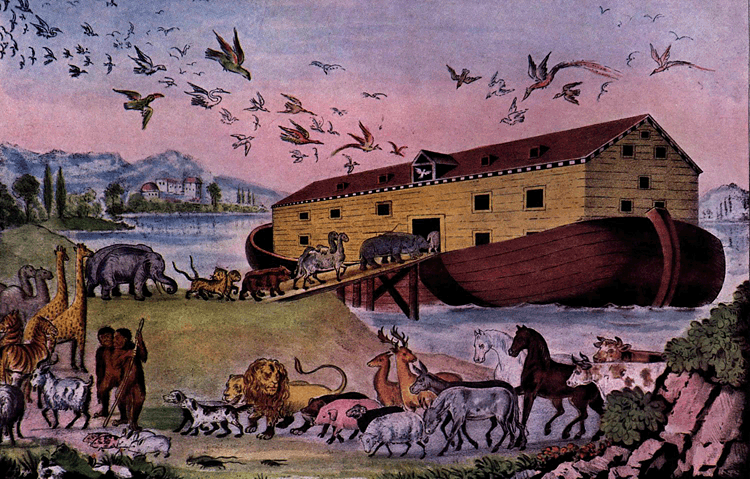
The unclean animals are a clear biblical metaphor for the lost and scattered Israelites returning to YHVH in the end times from the beast or heathen nations to where they have been scattered and where they have become like Gentiles or beasts of the field (Hos 2:16–19 cp. Acts 10:12, 28). This is illustrated in Peter’s vision of the sheet (Acts 10:12, 28), where the Gentiles are likened to unclean animals that YHVH has redeemed (Acts 10:12, 28 cp. with the great and innumerable multitude of Rev 7:9, the lukewarm believers of Laodicea in Rev 3:14–21, the thief on the cross, and the foolish virgins in Yeshua’s parable in Matt 25:1–13). The clean animals may represent the 144,000 of Revelation 7 and 14, and who are those saints, who have remained faithful in keeping YHVH’s Torah commandments, while at the same time maintaining faith in Yeshua the Messiah (Rev 12:17; 14:12).
Noah escaping the wrath of Elohim may be a antetype of the second exodus of end-times Israelites from the nations of the world. As a mixed multitude joined Israel in the exodus from Egypt, so even within Noah’s family there was a mixed multitude containing a spiritual tare; namely, Ham who later fell into sin (Gen 9:22–27) and become the father of the evil Nimrod (Gen 10). Even Yeshua had Judas, a tare, among his select group of disciples, and Yeshua teaches that the tares would coexist with the wheat up until the end times (Matt 13:24–30).
The waters that flooded the world both gushed up from out of the bowels of the earth and rained down from heaven (Gen 7:11). Water is often a biblical metaphor for the spoken word (e.g., Deut 32:2; Isa 55:10–11; John 9:6; Eph 5:26); namely, it represents both the Word of Elohim from above, and the word (philosophies, thoughts, ideas, religions) of man that are counter to the Word of Elohim and that have their source from below. In the last days, knowledge shall be increased, the devil shall spew out of his mouth deceptive words or philosophies like a flood in an effort to spiritually drown the world and even the saints through deception (Rev 12:15; Matt 24:14). Water can also be a judgment against men. YHVH will judge men for their words, philosophies and religions. Those who followed YHVH’s Word from heaven will be spared his wrath, while those who have subscribed to the words or philosophies of men from below will perish or be judged in a sea of men’s words that are often founded on doctrines of demons. Those who feed spiritually from the tree of knowledge (i.e., secular humanism and all the false religions and ideologies that have spawned from it) will die, while those who feed spiritually from the tree of life or the word of Noah (i.e., a prophetic picture Yeshua), the preacher of righteousness (i.e., the Torah, see Ps 119:172 and 2 Pet 2:5) will live. In the last days, the Word of YHVH will judge men, for when Yeshua returns to the earth on his white war stallion, the sword of the word of Elohim will be coming out of his mouth with which he will judge the nations (Rev 19:11–15).
It rained 40 days. This is another picture of judgment, since biblically, forty is the number of trials, testing or spiritual refinement.
The ark came to “rest” (Heb. nuach meaning “repose, settle down, be quiet”) on the mountains Ararat (Gen 8:4). From there, Noah built an altar and begin to rule the earth. This is a prophetic picture of Yeshua, at his second advent, coming to Zion or the Temple Mount where he will have his temple and will establish his kingdom on earth. It will be a time of peace on earth.
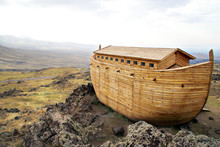
The word Ararat means “the curse is reversed.” The ark came to rest on Ararat during the Feast of Tabernacles or Sukkot. This is a prophetic picture of the saints coming to a place of spiritual rest at the beginning of the Millennium after the judgments of Elohim have been poured out on the wickedness of this earth and the wicked rebels have been destroyed.
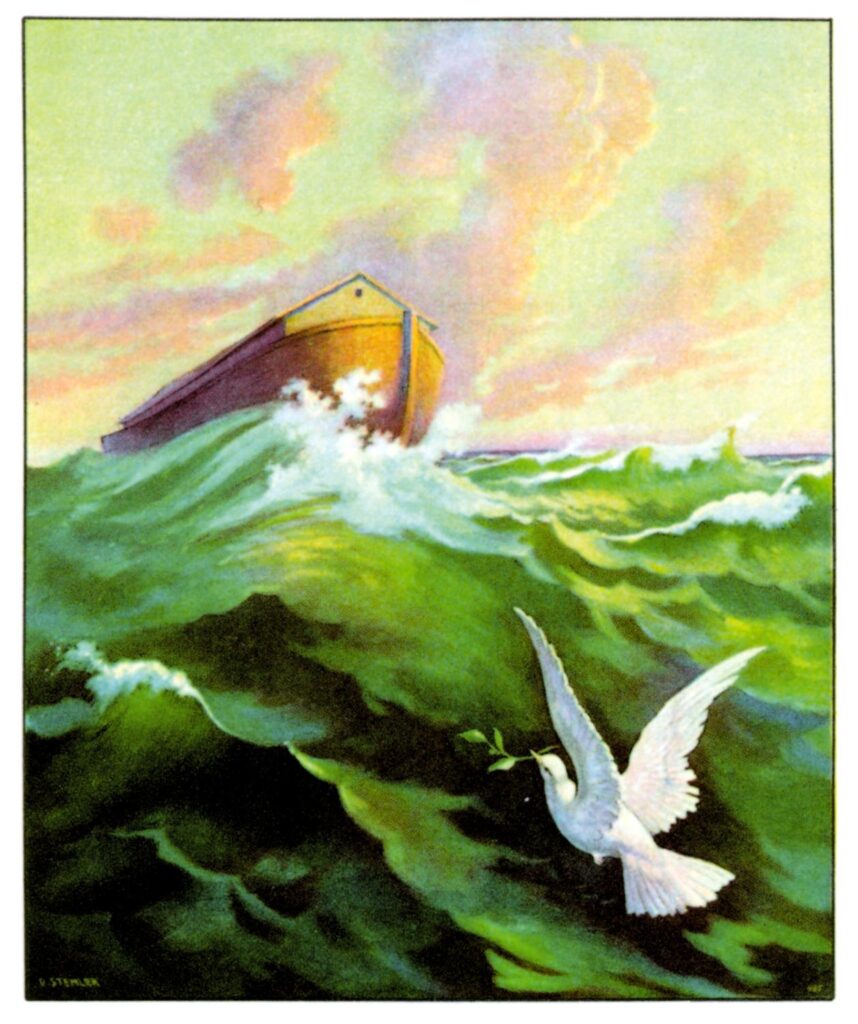
The dove is a prophetic metaphor for the bride of Yeshua who follows the Spirit of Elohim. The dove coming from the top window of the ark symbolizes the resurrected and glorified bride of Yeshua coming back to earth from heaven to rule with Yeshua on earth (Rev 19:1ff). The dove left and came back on the seventh day—the Shabbat. This is a picture of the Millennium or the seventh millennia of man’s existence on earth. Several times in the story of Noah, it is mentioned about the dove finding rest or not finding rest. This is another picture of the Millennium—a time of rest for the saints or the bride of Yeshua (Heb 4:1–10).
The raven who feeds on carrion is a metaphor for the devil who feeds off of dead meat of lost and wicked men, and who is actively trying to kill, steal and destroy (John 10:10) like a ravenous lion (1 Pet 5:8). Satan will be active at the end of the Millennium, as well, when he will be loosed from the pit for a short season from which he will go to the wicked rebels in Gog and Magog where he will incite them come against Yeshua and the saints in Jerusalem (Rev 20:7–10).
Noah’s altar may well be a picture of the third temple that will be built in Jerusalem during the Millennium (or Ezekiel’s temple, Ezek 40–48).
According to Christian commentator Matthew Henry, Noah’s ark was an early Christian metaphor for salvation and YHVH’s delivering his people form evil and judgment against wickedness. We see this allusion in 1 Peter 3:20–22 where the flood is a picture of salvation, deliverance by baptism and the resurrection of Yeshua.
The ark was covered with pitch, which is a picture of the redeemed believer being covered by the blood of Yeshua to keep the spiritual ark of his life from sinking under the judgment of Elohim against men’s sin. This truth of this imagery is revealed in the Hebrew words for pitch and atonement, which share the same root word in Hebrew.
The name Noah means “rest.” Yeshua bids all who are heavy laden and need rest to come to him (Matt 11:28–30).
Noah was 600 years old when he went into the ark and the flood came. YHVH’s final judgment against wicked men will be at the end of the 6000 years of men’s rebellious tenure on this earth.
Noah did not leave the ark and set foot on the earth until YHVH bade him to do so (Gen 8:15). Likewise, Yeshua will not return to the earth from heaven until the Father permits it.
The Noachic Covenant that Elohim made with all humanity (Gen 9:1) is a picture of the New Covenant (also referred to as the “Everlasting” or “Perpetual Covenant”; Isa 55:3; Jer 32:40; 50:20; Ezek 16:60; 37:26; Heb 13:20;) being ratified in the Millennium with “all Israel.” No non-Israelites (i.e., no sinners) will be permitted to live, but will be burned up in the lake of fire at the end of the Millennium (Rev 20:11–15).
Genesis 7
Genesis 7:2, Of every clean animal. There are Christian Bible teachers who claim that the Torah-laws YHVH gave to Moses were for the children of Israel only and not for anyone else, and that prior to Mount Sinai not only was the Torah unknown to man, but it was not a requirement of him. On the contrary, the fact that YHVH told Noah to preserve clean animals on the ark proves that the Torah’s dietary laws were in fact known to man prior to Mount Sinai.

Genesis 7:4, Forty days. For 40 days it rained upon the earth. Forty is the biblical number for trial, testing, spiritual refinement and divine judgment. For example, YHVH tested and refined Moses in the wilderness for 40 years while shepherding sheep and prior to his call to lead the Israelites our of Egypt. Then YHVH made the Israelites wander in the wilderness 40 years as a judgment against their sin of unbelief and hardness of heart. Later, Yeshua fasted and was tested for 40 days in the wilderness in preparation for his earthly ministry. Similarly, the 40 days it rained on the earth during the flood of Noah is a prophetic antetype of YHVH’s final wrath being poured out upon this earth (Rev 15–16).
Likewise, YHVH’s saints will go through a time of spiritual testing and refinement prior to YHVH pouring out his wrath upon wicked mankind. We see this see in the context of Revelation 11:18, which prophesies the resurrection of the saints to meet Yeshua in the air and which occurs after the seventh trump has sounded. This means that the saints will have already gone through the refining times of the seven seals and the seven trumpets mentioned in the Book of Revelation prior to their resurrection. Yeshua confirms this in his Matthew 24 prophecy, where we find that YHVH’s saints will still be on the earth during the tribulation and great tribulation period at the end of this present age (Matt 24:29–31).
Genesis 7:4, 10, After seven days. Noah was a preacher of righteousness for 120 years prior to the flood (Gen 6:3; 2 Pet 2:5). He no doubt endured the mockery and persecution of those who refused to believe his message about a coming flood, and mocked his building an ark of safety or salvation, when that generation had neither previously experienced rain much less floods (Heb 11:7; 2 Pet 2:5).
In Genesis 7:4 and 10, we learn that YHVH allowed Noah to experience seven more days of persecution before the rains of judgment come upon the earth. Afterwards, YHVH shut Noah and his family up in the ark of safety (Gen 7:16) after which the ark “was lifted above the earth” (Gen 7:17). Yeshua likens the end times just prior to his second to the days of Noah (Matt 24:37–39). Yeshua further teaches that his saints will not only go through tribulation on this earth (Matt 24:3–22), but that his people will even go through “great tribulation” (Gr. megathlipsis, v. 21).
After this, Yeshua teaches that the saints will be lifted up above the earth to meet him in the air after the great tribulation (Matt 24:29–31 cp. 1 Thess 4:16; 1 Cor 15: 51–53). Thus the notion of a pre-tribulation rapture as many false teachers in mainstream Christianity teach is an erroneous fantasy.
The Scriptures reveal that Noah endured another seven days of tribulation before the wrath of Elohim was poured out upon the wicked inhabitants of the earth. This may be a prophetic picture of a seven-year tribulation period the saints will go through before the wrath of Elohim (which is different than the tribulation period) is poured out upon this earth (See Rev 11:15–18 [compare with 1 Cor 15:51–53] and chapters 15 and 16 where the seven last plagues are called the wrath of Elohim).
The Scriptures clearly teach that YHVH’s people will not have to endure his wrath (1 Thess 1:10; 5:9), but conversely teaches that all will go through tribulation (John 16:33; Acts 14:22; Rev 7:14). Scripturally, tribulation and wrath are two different words and concepts.
Genesis 7:11, Broken up. Heb. baw-kah’ meaning “to cleave, to rend, break, rip or open” and is translated in the KJV as “to make a breach, break forth (into, out, in pieces, through, up), be ready to burst, cleave (asunder), cut out or divide.” This was a major catastrophic event of unimaginable proportions that the mind cannot fathom! This cataclysmic global flood that befell the earth because of the angelic incursion and man’s rebellion demonstrates the intense and furious wrath and the divine judgment of YHVH Elohim against those who would corrupt and destroy those whom he had created in his image with the potential to be his glorified children. A similar judgment against wickedness will occur again, but this time by a fire that will consume the entire earth (2 Pet 3:10–13). This time, rather than angels having sex with humans, the wrath of Elohim will likely be brought on by humans toying with the human genome through the melding of genetic modification, transhumanism, robotics and artificial intelligence.
Genesis 7:23–24, Only Noah. As Noah was saved from divine judgment in an ark of safety of YHVH’s design, even so today’s righteous saints have a similar ark of safety. Yeshua is that spiritual “ark of safety” for all who will surrender to him. Once a person is “inside” of a spiritual relationship with Yeshua, they will be spared from the wrathful judgments of Elohim (John 5:24–29; 1 Thess 1:10; 5:9 cp. Zeph 2:3; Luke 21:36; Rev 11:15–18; 14:4–5 cp. Rev 14:14–20).
Genesis 9
Genesis 9:1–11, The Noachide Covenant. Elohim gave these basic laws as his lowest standard of righteousness to maintain order and civility on the earth and thus to ensure the continuation of the human race (The Bible at Qumran, p. 142 in an article by James C. Vanderkam; Peter W. Flint edit.). Later when YHVH called Abraham and his descendants out from of the seas of humanity, he gave these chosen people his Torah-instructions in righteousness as a means to draw closer to him. Thus the Noachide laws were given for the preservation of the physical human race, while the Torah was given to produce and preserve a race of upward bound, Spirit sons and daughters of YHVH Elohim.
Genesis 9:3, Every moving thing shall be food for you. See Genesis 7:2, 8 where Elohim differentiates between clean and unclean meats, that is, those animal meats which are permissible to eat and those which are not. Thus this verse cannot be used as a justification to eat any unclean or nonkosher animal or else it would be contradicting the previous instructions by example that YHVH had given to Noah.
Genesis 9:4, Life, that is its blood. Although modern medical science fails to understand this, a person’s soul life, that is, his mind, will and emotions, is located in the blood. When the blood is spilled, the soul ceases to exist. The soul that sins dies or ceases to exist (Ezek 18:4, 20).
Genesis 9:10, The Noachide Covenant was made with the animals too.
Genesis 9:11, Never again. This verse proves that Noah’s flood was universal. Since that time, there have been localized floods that have caused great destruction but never a universal one. If Noah’s flood was a local one, then YHVH has broken his promise many times since then.
Genesis 9:13, Rainbow. The rainbow is a glorious symbol of two opposing spiritual realities and forces relating to Elohim’s righteousness and holiness. First, it speaks of his grace in that he will not bring the cleansing judgment of water on the earth again. At the same time, it speaks of his judgment against the evil of the pre-flood world. When the modern homosexual movement has appropriated the rainbow as its symbol, it fails to realize that the rainbow is a double edged sword representing both the mercy and the judgment of Elohim. It is both ironic and prophetic that in looking to the rainbow as their representative symbol, homosexuals are unwittingly recognizing and even declaring the ultimate judgments of a righteous and set-apart Elohim against man’s wickedness and rebellion including the sin of homosexuality.

Although Elohim promised to never again judge man for his wickedness through drowning, he will, at the end of the age, judge men by fire and at the same time purify the earth of the wickedness men have committed on it (2 Pet 3:7 cp. Isa 51:6; Rev 20:15; Matt 25:41). Water only partially cleans the surface of things, while fire cleanses more deeply and thoroughly. It is necessary for the earth to experience a deep cleaning in preparation for it to be a suitable habitation for Elohim and his glorified sons and daughters in the new heavens and earth.
Genesis 9:22–24, Saw the nakedness of his father. To uncover a man’s nakedness is a biblical metaphor or Hebraism meaning “to have a sexual relationship” with a man’s wife. (Lev 20:11; Deut 27:20; also Lev 18:6–19; 20:18–19; Ezek 22:10). (Lev 18:8). Behind this Hebraisms, the implication that Ham had an incestuous relations with his mother, while Noah was intoxicated, resulting in the birth of Canaan. Canaan was cursed because he was the result of incest, and because of this he and his offspring couldn’t receive the full blessing of Noah without incest being dignified and legitimized.

Genesis 9:25, The earth was divided [lit. split]. This appears to be a reference to the one continent called Pangea that existed before earth’s continents were divided. This verse tells us that the earth was divided or split (Heb. palag/dkP) in the time of Peleg (Heb. dkP meaning “earth quake”). There is a Hebrew wordplay between Peleg and palag. The division of the continents occurred after the flood. Interestingly, the existence of Pangea is suggested first by how the current continents fit together like puzzle pieces, second by the geologic phenomenon of continental, and finally by the fact that some continents that are currently separated by great distances share common flora, fauna and geological formations and rock types.
Genesis 9:27, May he dwell in the tents of Shem. Who is the antecedent of “he”—Elohim or Japheth? If the former, as Matthew Henry and Adam Clarke suppose, then this is one of the earliest—perhaps the third—Messianic prophecy in the Bible predicting that the Messiah would be a descendant of Elohim himself. Keil and Delitzch, on the other hand, attribute the he to Shem. Perhaps the Hebrew is deliberately unclear here thus cryptically suggesting that both interpretations are correct. That is, that Messiah would be both a descendent of Elohim and Shem—the God-Man, as we know that Yeshua was. All three commentaries point out that to Shem was given the spiritual blessing, while Japheth received the double-portion physical blessing. As Clarke points out, this subdivision of Noah’s blessing is suggested by the names of his two sons. Shem means “name” as well as “the reputation and character of a person,” while the name Japheth signifies “expansion” thus suggesting enlargement of future geography, prosperity and posterity.
Canaan shall be his servant. Why did YHVH put the descendants of Ham under the servitude of Shem? Perhaps it was because Shem was righteous as was his lineage from which came the descendants of Abraham, and thus the Semites, who YHVH would task with governing and guiding the unruly Hamites in the paths of Torah righteousness. Indeed, among the descendents of Ham in Africa and parts of the Middle East, there has been non-stop tribal warfare for millennia until the mitigating influences of Christianity (the roots of which go back to Abraham) brought an end to the majority of the internecine conflicts in this region of the world. This all changed when Islam invaded and took over many of these regions, and bloody conflicts were renewed and continue to this day.
Genesis 10–11
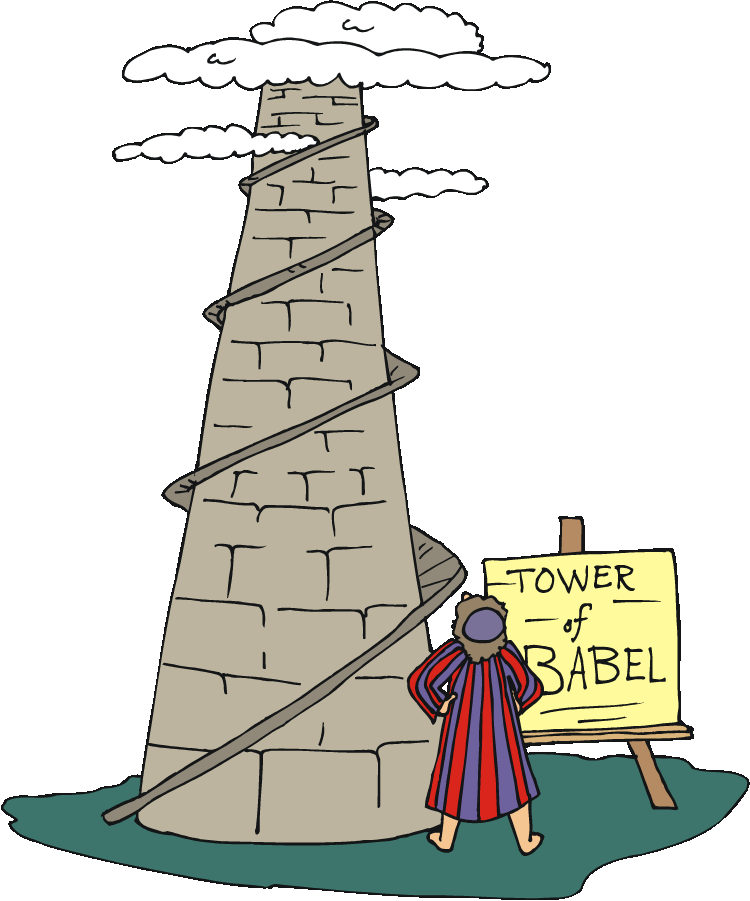
Genesis 10:8–9; 11:1–9, Nimrod…Babel. Comparisons can be made between Nimrod and his rebellion against Elohim (and apostasy from the faith of his fathers) with that of the man of sin (literally, “the man of Lawleasaness/Torahlessness” in 2 Thess 2:1–12) in the end times. We can also compare the formation of Babylon and the building of the Tower of Bavel to the end-time one-world system called Babylon the Great (Rev 18). For the present, let’s explore how Satan, the devil-serpent, has been the motivating force behind collectivization and organization of humans in his rebellion against YHVH Elohim, the Creator. (To read further on this subject, click on the link below:
https://hoshanarabbah.org/blog/?s=Secular+Humanism&submit=Search
Genesis 10

Genesis 10:9, A mighty [ Heb. gibbor] hunter before [Heb. lipney] YHVH. Lipney is a preposition meaning “in the presence of, or literally in the face of.” This is a variation of the its verbal root, paniym meaning “faces” but with the prefixed preposition of in giving its fuller meaning of “at/to/in the face of” and with the suggested meaning of “in full view of, under the eye of.” Gibbor meaning “powerful and by contextual implication a warrior or tyrant” is found twice in this verse as if to emphasize the fact that this was a defining characteristic of Nimrod vis-à-vis YHVH. That Nimrod was a hunter (Heb. sayid) can be taken in its literal sense to mean “a hunter of game animals” or metaphorically as “one who pursues the life of another to destroy it,” according to The TWOT, as it is so used regarding the adulterous woman who pursues her male prey (Prov 6:26). Both senses may have been true of Nimrod, since in establishing cities and empires seldom is war and conquest not part of the process because most humans innately prefer freedom as opposed to being ruled over tyrannically by other humans. These activities of Nimrod were done in plain sight of or in the presence of YHVH, and in view of the outcome of his actions and the rebellion to which they led, it may be supposed that it was an act of defiance against YHVH resulting in divine judgment of humans at Babel.
Genesis 10:25, The earth was divided. Divided is the Hebrew word palag meaning “to split or cleave.” In verse five, we read about the Gentiles of the islands or coastlands. Between the two verses is it possible that the supercontinent of the earth (or Pangaea) split or divided into the seven continents that we have today? The confusion the languages caused the human race to be split or divided across earth as well. In the Hebrew there is an interesting poetic wordplay between Peleg/glp and the Hebrew word palag/glp meaning “to split or divide,” where the consonants are the same although the vowels are dissimilar. Also note verse 32 where the nations were divided (Heb. pârad or separated or spread) after the flood. The separating of the continents would have accomplished this. This would have been an geological example of catastrophism as opposed to uniformitarianism upon which the theory of evolution is based.
Genesis 11
Genesis 11:1–32, The list or table of nations. Apparently 70 nations are mentioned in this chapter. Interestingly, 70 descendants of Jacob went down to Egypt, Moses chose 70 Israelite elders to be judges in Israel which eventually became the Israelite high court or Sanhedrin, and Yeshua had 70 disciples beyond the twelve. All of these groups of 70 speak of nations, leadership and judgment and evangelism with regard to the nations of the world. This hints at YHVH’s ultimate plan for the nations of the earth, who was to lead them and whose divine mission it was to spread the good news of the kingdom of Elohim to them.
Genesis 11:1, The whole earth…one language. That language was Hebrew. How do we know that? Because all the names of people before the confounding of the languages were Hebrew names with Hebrew meanings (e.g., Adam, Eve, Seth, Cain, Abel, Noah, etc.). The meanings of these names don’t correlate one hundred percent across the board to any other language except Hebrew. Moreover, the linguistic science of Edenics shows evidence that all the languages of the world trace back to Hebrew (for proof, see the work of Isaac E. Mozeson in his book, The Word, The Dictionary That reveals the Hebrew Source of English). Some scholars speculate that in ancient times that there existed a language called Proto-Hebrew that was akin to but different from biblical Hebrew. This is pure speculation, since no examples of this language have ever been found. Nevertheless, the biblical record proves that biblical Hebrew was the original language of creation.
Genesis 11:2, Shinar. Shinar is south and east of the mountains of Ararat, which is in the extreme eastern area of modern Turkey. Shinar is another name for Mesopotamia or Babylonia and is in the area between the Tigris and Euphrates rivers in modern Iraq.
Genesis 11:4, Reach unto heaven…make us a name.
Genesis 11:9, Babel. There are several opinions among Hebrew scholars on the meaning of babel. The TWOT defines it as “mix, mingle, confuse, confound,” while BDB defines it if connected etymologically to Assyrian as “gate of God,” but if originating from Hebrew it means “confuse, confound.” Since biblical writers will often employ words-plays (take a word and change it slightly to convey a different, often sarcastic or derisive connotation) as a literary device, it is possible that babel could mean either confusion (because of its similarity to the Hebrew word balal or “the gate of El” from the Aramaic. The Bible reveals that at Babel, YHVH confounded the languages because men were trying to build a gate way to heaven (Gen 11:4).
Genesis 11:10, Shem. Shem lived for 600 years—100 years before the flood and 500 years after. Shem outlived Abraham. According to some genealogical charts, Shem died toward the end of Isaac’s life and while Jacob was a middle-aged man.
Genesis 11:7, Us.This may refer YHVH the Father in heaven and the Son, who his messenger working out his plans on earth. It may also refer to the divine counsel that exists in heaven that comprises the spirit beings in the court and throne room of heaven to which the Bible alludes in several places.
Genesis 11:27, 31, 32, Haran. Haran (i.e., Charan) the city is spelled with a chet, while Abraham’s brother, Lot’s father begins with a hey. Therefore, Charan was not named after Haran.
Genesis 11:29, Iscah. (See notes at Gen 20:12.) According to rabbinical commentary, Iscah is another name for Sarah, Abraham’s wife. It was not uncommon in ancient and Hebraic culture to have more than one name. We find this to be the case in the Scriptures in many instances. For example, Jethro (Heb. Yitro, Exod 3:1), the father-in-law of Moses, was known by two other names: Hobab (Num 10:29; Judg 4:11) and Reuel (Exod 2:18). Sometimes a person’s name would reflect exploits or achievements accomplished in that person’s life, one’s character traits or one’s destiny. Often when one was given a new mission or calling in life a new name was given to that person to reflect their new destiny. Examples of this would be Abram (“exalted father”)becoming Abraham (“father of a multitude”), Sarai (princess) becoming Sarah (“noblewoman, queen”), Jacob (“prevailer, heelcatcher”)becoming Israel (“El prevails, prince of El”), or Hoshea (“savior, deliverer”) becoming Joshua/Yehoshua (“Yah saves/delivers”). Similarly, it is not uncommon for both Jews returning to the land of Israel and redeemed believers returning to the Hebrew roots of the Christian faith to take a new name to reflect their new spiritual journey, mission, destiny or identity. Some may think this a strange thing to do, but in Hebraic culture this was a very acceptable practice. Often Elohim did the renaming as in all the examples given above.
Interestingly, YHVH promises a new name as part of their spiritual inheritance to those saints who overcome the world, the flesh and the devil (Rev 2:17; 3:12). Do you have your new name yet?
Genesis 11:31; 12:1, Ur of the Chaldees…land of Canaan. YHVH commanded Abraham to leave Ur of the Chaldees, the ancient region of Babylon, which means “confusion” or “mixture” as in a little good and a little evil like the tree in the Garden of Eden by the same name from which the serpent enticed Adam and Eve to eat. Has YHVH put out an end-time call to his set-apart people to leave an end-time religious system that is comprised of a little good and a little evil? (See Rev 18:4.) Is he calling a remnant to come out of religious confusion/Babylon back to Canaan, the Land of Israel, to reunite with the Hebraic/Abrahamic roots of their faith? Are you heeding that call? What are you doing about it?

